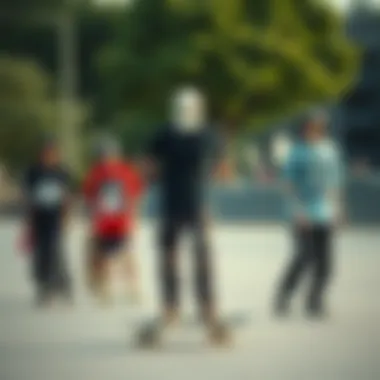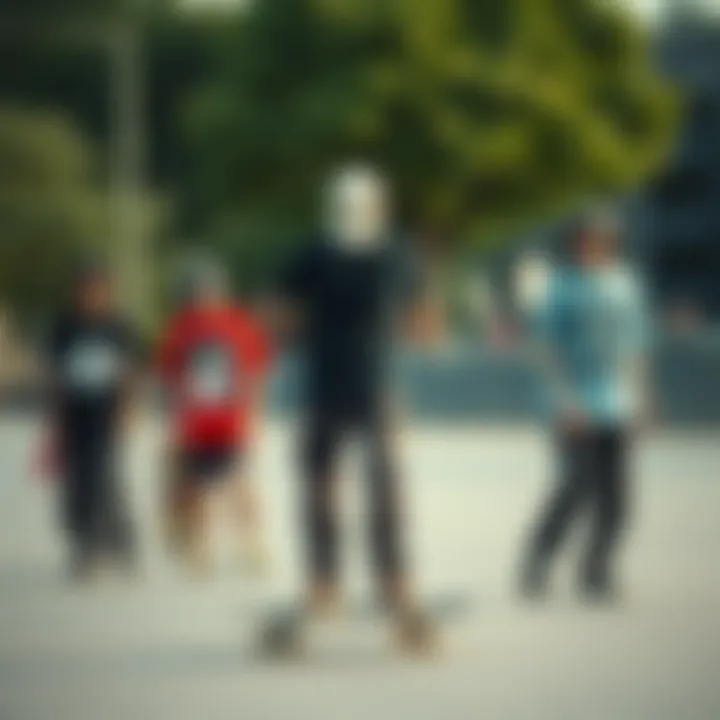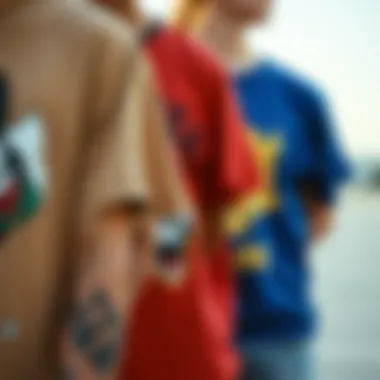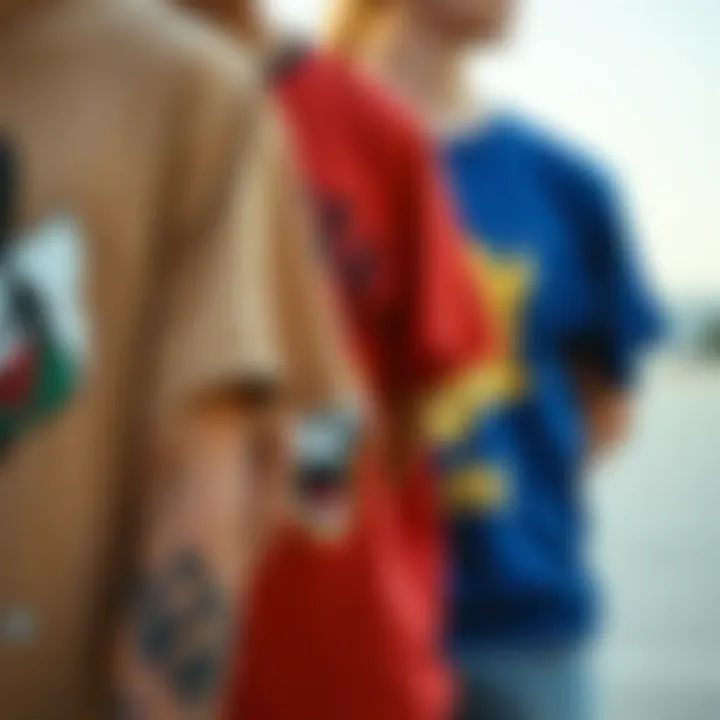Streetstyle T-Shirts: Their Role in Skate Culture


Intro
Streetstyle t-shirts are more than just pieces of clothing; they represent a way of life for skateboarders. These tees often embody the spirit of rebellion, creativity, and freedom that is essential to skate culture. From their origins on the streets to their influence on skateboarding techniques, they play a pivotal role in shaping identities within the community.
As both a fashion statement and a form of self-expression, these t-shirts reflect the diverse subcultures and artistic inspirations that encompass skateboarding. By examining their evolution and design influences, we gain insight into the intricate relationship between fashion and skateboarding, revealing how individuals use clothing to convey their beliefs and aesthetic.
Skateboarding Techniques
In the same way that t-shirts reflect personal style, the techniques skateboarders employ serve as a form of expression on the board. The tricks developed over decades range from basic to advanced, paralleling the evolution of streetstyle clothing.
Essential Tricks for Beginners
- Ollie
The foundational move that allows skaters to jump with their boards. The ollie serves as the gateway to many other tricks. - Kickflip
A step up from the ollie, the kickflip involves flipping the board in mid-air by flicking the edge with the toes. - Pop Shuvit
Similar to an ollie but with an added twist, skaters pop the board while spinning it underneath.
When decked out in comfortable streetstyle t-shirts, beginners feel more confident as they learn these foundational maneuvers. Skateboarding goes beyond tricks; it’s about the camaraderie that comes with finding a shared identity.
Advanced Maneuvers for Seasoned Skaters
- 360 Flip
Combining a kickflip with a pop shuvit, this trick requires a high level of skill and precision. - Smith Grind
A rail trick that is not just about technique but also style, often accented by vibrant t-shirts that showcase personal brands. - Heelflip
Similar to a kickflip, but a skater uses the heel to initiate the board's flip.
As skaters master these tricks, they further integrate their fashion choices with their techniques, enhancing their visual identity in the skate community.
Skate Culture
The evolution of skateboarding styles has evolved hand-in-hand with the designs of streetstyle t-shirts. Each era has been marked by distinct aesthetics, such as the punk influences of the 1980s, or the grunge vibes of the 1990s.
The Evolution of Skateboarding Styles
Skateboarding has gone through various phases, from vert ramps to street skating. Each style influences the type of apparel that skateboarders choose to wear:
- Punk Influence (1970s-1980s)
T-shirts with graphics and slogans became symbols of rebellion, echoing the music scene at the time. - Grunge Era (1990s)
Oversized tees and flannel were adopted by skaters, merging music and fashion, further enriching the culture. - Contemporary Trends (2000s-Present)
The rise of specific streetwear brands has infused skate fashion with urban art and innovative designs, making t-shirts integral to skaters’ self-expression.
Community Engagement and Local Events
Streetstyle t-shirts often serve as a uniform at local events, fostering unity amongst skaters. Clothing choices during competitions or local jam sessions can reflect a collective identity. Events such as the X Games demonstrate how street fashion complements talent and creativity.
"T-shirts are not just fabric; they're a canvas for expression among skateboarders, displaying what we believe in and where we come from."
In essence, the world of skateboarding is intertwined with streetstyle. It’s not simply about riding a board but about conveying who you are through your personal attire. This piece promises to take a closer look at how these seemingly simple garments encapsulate the essence of skate culture.
Intro to Streetstyle T-Shirts
Streetstyle t-shirts are more than just garments; they are vital pieces of a cultural puzzle that encapsulates the essence of skateboarding. With roots deeply embedded in the youth culture of the 1970s and 80s, these shirts capture a particular spirit—one that resonates with self-expression, community, and a touch of rebellion. In a world where commodification often overshadows authenticity, streetstyle t-shirts serve as a counter-narrative, empowering individuals to showcase their identity and affiliations.
As we peel back the layers of their significance, we find that streetstyle t-shirts not only define personal style but also act as conversation starters, bridging gaps between generations and subcultures. The bold graphics, vibrant colors, and unique designs reflect the creativity of not just the wearer but the entire skate community, making these t-shirts a canvas for artistic expression.
Moreover, these garments hold functional values; they are typically designed with comfort and mobility in mind, allowing skateboarders to move freely. This practicality aligns seamlessly with the lifestyle of skaters, further solidifying the t-shirt's role in their everyday wear. Skating isn’t merely about tricks and flips; it’s also about representation—how one identifies within this diverse culture is subtly communicated through what they wear.
"Streetstyle t-shirts are not just fabric stitched together; they're layers of identity, creativity, and culture wrapped into one."
T-shirts in this scene are often adorned with graphics from iconic brands or local street artists, which leads us into a deeper exploration of their impact on skate culture. As we continue, it becomes essential to understand that while these t-shirts carry aesthetic values, they are also vessels that convey messages about the wearers’ social standing, affiliations, and attitudes. This multifaceted nature is what makes streetstyle t-shirts a topic worth exploring.
Historical Context of Skateboarding Fashion
Understanding the historical context of skateboarding fashion provides an essential backdrop for analyzing the influence of streetstyle t-shirts within this vibrant culture. Skateboarding originated in the cauldron of 1950s California, where surfers sought to replicate their oceanic thrills on land. This laid the groundwork for a community that not only valued the adrenaline rush of skating but also fostered a unique fashion sense that has evolved over decades.
T-shirts have always been more than mere garments in skate culture; they act as canvases for expression, providing skateboarders a means to communicate their identity and values. The combination of practical needs for movement and artistic expression contributed to the early adoption of t-shirts among skaters. These garments became tools for community building, enabling individuals to showcase their affiliations and artistry through various styles and graphics.
Historically, the appearance of skate culture on the streets led to a fabrication of identity that combined rebellion with creativity. Brands like Vans and Thrasher emerged in the 1970s, pioneering a shift in how fashion intersected with skateboarding. The importance of this historical context cannot be overstated, as it sets the stage for the cultural significance and evolution of streetstyle t-shirts within the scene.
Origin of Skate Culture


Skate culture took root in California's sun-soaked streets, primarily in the 1970s, where kids began using makeshift skateboards—a wooden board with roller skate wheels. This playful experimentation was a radical departure from traditional sports and quickly morphed into its own scene. As skateboarders sought new locations, they found themselves in urban environments where they could hone their skills. The streets became their playground.
Technological advancements, such as solid polyurethane wheels and wider boards, transformed skateboarding from a novel pastime to a thrilling sport. As a result, skateboarding evolved into an art form, providing a basis for creativity both in performance and in style. The skateboard became a vehicle not just for tricks, but for a broader cultural identity that would extend to music, attitude, and yes, fashion.
Evolution of Streetstyle Clothing
The evolution of streetstyle clothing is woven intricately with the progression of skate culture. By the 1980s and 1990s, skaters began to eschew formal wear in favor of more relaxed, practical clothing. T-shirts started to play a central role as they offered comfort and breathability while skating.
Brands quickly capitalized on this opportunity by creating clothing that resonated with the skater's ethos. Graphics on t-shirts became a medium for expression, showcasing everything from favorite skate brands to political statements. Here’s how this evolution unfolded:
- Graphics and Logos: The proliferation of logos defined the identity of skate crews and brands. A simple t-shirt featuring a company logo could signify allegiance to a particular skate outfit or group.
- Collaboration and Innovation: The fusion of skate and street fashion is perhaps best exemplified by high-profile collaborations between skate brands and mainstream fashion houses, allowing skate t-shirts to break out from niche markets into broader visibility.
- Cultural Commentary: More than just appealing designs, t-shirts have served as cultural commentaries, reflecting sentiments on social issues, making statements about environmentalism, or rallying support for various causes.
The transformation of streetstyle clothing demonstrates how intertwined fashion and culture are in skateboarding, emphasizing that t-shirts are, in essence, a language of expression that speaks volumes about identity, community, and rebellion against norms.
"Street fashion is a reflection of the world. It's a way to say who you are without uttering a single word."
The historical context of skateboarding fashion thus serves as a pivotal element in comprehending how streetstyle t-shirts have evolved to become symbols of identity, creativity, and community within skate culture.
The Rise of T-Shirts in Skate Culture
The rise of T-shirts in skate culture signifies more than just a clothing trend; it marks the intersection of fashion, identity, and the vibrant lifestyle of skateboard enthusiasts. These unassuming pieces of fabric have transcended their practical purpose to become iconic symbols of self-expression within the skate community.
Historically, T-shirts were the humble garb of the working class and later evolved into a canvas for art, opinion, and individual style. For skate culture, this evolution was pivotal as it provided a backdrop against which skateboarders could showcase their affiliations, beliefs, and creativity.
Iconic Brands and Their Impact
When delving into the brands that have shaped the landscape of skate T-shirts, one cannot overlook the influence of companies such as Supreme, Thrasher, and Vans. Each of these brands not only contributes to the fashion aspect but also encapsulates a lifestyle and ideology that resonates with skaters.
- Supreme: Known for its bold box logo and limited collaborations, Supreme's T-shirts symbolize exclusivity and street-savvy appeal. Skateboarders often view owning a Supreme T-shirt not just as a matter of fashion but as a badge of honor in a world where authenticity reigns supreme.
- Thrasher: This magazine-turned-brand is emblematic of skate culture itself. The "Thrasher" logo is now more than just a graphic; it represents a lifestyle, a community, and an attitude. Wearing a Thrasher T-shirt makes a statement, signaling allegiance to the skateboarding world.
- Vans: Famous for their footwear, Vans has cleverly transitioned into T-shirt design that features themes revolving around skating and youth culture. Their designs often nod to vintage aesthetics while promoting the idea that skateboarding is for everyone.
Street Artists and Graphic Designs
Graphics on T-shirts often tell stories that can resonate deeply with the wearer. Street artists, once relegated to alleyways and subway walls, have found a canvas in these garments. The freewheeling creativity associated with skate culture is perfectly complemented by the raw, unfiltered art styles that define urban street art.
- Impact of Street Art: Graphics created by street artists incorporate messages that challenge societal norms or reflect personal experiences. Wearing a T-shirt adorned with street art not only showcases an appreciation for the artist's work but also engages conversations about the messages behind the art.
- Community Identity: These graphic designs often foster a sense of belonging among skaters. When one wears a T-shirt featuring a particular artist or design, it helps forge connections with others who share similar artistic tastes or skateboarding experiences.
- Boosting Local Artists: Brands looking to innovate their T-shirt designs often collaborate with local street artists, thus promoting regional talent and providing artists a platform to reach a broader audience, fostering a mutually beneficial relationship that enhances the richness of skate culture.
In summary, from branded impact to localized artistry, the rise of T-shirts in skate culture is a testament to the garment's evolution into a multifaceted medium of identity, expression, and community.
Design Elements of Streetstyle T-Shirts
The design elements of streetstyle t-shirts are fundamental in shaping not just the garment itself, but also the identity it conveys within the skate culture. For skaters, t-shirts represent more than just clothing; they’re a canvas for self-expression, a medium for artistic creativity, and a statement of personal style. The design intricacies involved in these t-shirts can influence trends, embody community values, and communicate various messages that resonate deeply with both the wearers and onlookers.
Material and Cut Considerations
When discussing streetstyle t-shirts, one cannot overlook the critical role materials and cuts play. Comfort is king in the skateboarding world; after all, no one wants to ride with a shirt that restricts movement. Skate t-shirts are typically crafted from cotton or blends that provide breathability and flexibility. Whether it's a lightweight, soft cotton or a more durable fabric, skaters tend to favor options that can withstand the grip of a skateboard and the grind of the pavement.
Cut Variations
The cut of a streetstyle t-shirt can vary significantly, and these variations serve various comfort levels and occasions:
- Classic Fit: This standard cut is roomy and allows for unrestricted arm movement, making it ideal for skating.
- Slim Fit: Some skaters prefer these for a more contoured look, although they might feel snugger during tricks.
- Oversized: Reflecting a laid-back style, oversized t-shirts have gained popularity. The extra fabric adds a relaxed vibe and can often be paired with tapered bottoms.
Benefits to Skaters
- Functionality: The right material and size can ensure the t-shirt performs well during stunts.
- Durability: High-quality fabrics stand up to wear and tear from falls or dirt.
- Layering: A good fit offers versatility for layering under hoodies or jackets without feeling cumbersome.
Color Palettes and Patterns
The color palette and patterns used in streetstyle t-shirts often reflect the cultural backdrop of skateboarding. Bright colors can signify energy and creativity, while monochromatic schemes might convey a more serious tone. The choice of colors is not just about aesthetics; it also communicates a deeper connection to the ethos of skate culture.
Trends in Color Choices


- Muted Earthy Tones: Often inspired by the skate park environment, colors like olive green, brown, or rusty orange have become quite popular.
- Neon and Bright Splashes: Favored for their eye-catching appeal, these colors are often used in graphic designs to attract attention.
- Black and White Combos: Timeless and versatile, they can be paired with almost anything and are particularly favored in graphic tees.
Patterns and Graphics
The graphics featured on streetstyle t-shirts range from artistic designs to stark statements. Skate culture has a rich visual language that students of the sport embrace:
- Logo Prints: Brands like Palace or Supreme often feature bold logos front and center, making it easy for fans to showcase their brand allegiance.
- Artistic Illustrations: More intricate designs can express individual artistry or social commentary, adding depth to the t-shirt's message.
- Abstract Patterns: These can embody the chaotic energy of skateboarding, with swirling designs or graffiti-like aesthetics.
The essence of a t-shirt is not bound just in its threads, but in how it brings skaters together, creating a sense of belonging within the community.
When skaters choose a t-shirt, they aren't merely picking a piece of clothing. They select a representation of their lifestyle, their affiliations, and their voice in a world that often seeks to define them. It's these design elements—the materials, cuts, colors, and patterns—that unite skaters in both identity and expression, weaving the fabric of skate culture together.
T-Shirts as Expressions of Identity
T-shirts are more than mere pieces of fabric draped over skins; they are canvases for identity that skateboarders wield like brushes, painting their individuality across the urban landscape. In this realm of street culture, the choice of a T-shirt becomes an act of defiance, creativity, and self-assertion. The significance of t-shirts in expressing identity within the skateboarding community cannot be overstated. They embody not just personal style but the very essence of who a skater is.
Personal Style and Individuality
Each skateboarder has a unique narrative, and t-shirts often serve as the first chapter in that story. A graphic tee displaying the vibrancy of pop culture or an obscure indie band tells the world where their interests lie. Notably, the designs can range from intricate artwork representing skate brands to simple slogans that resonate with personal philosophies.
This expression can be seen in the preference for certain colors and cuts that reflect their individual personalities. Some gravitate toward oversized fits that echo a laid-back vibe, while others prefer fitted styles, accentuating their physique—a subtle nod to their commitment to style. Customization is also a common theme; adding patches or altering a shirt into something entirely different transcends mere clothing, transforming the T-shirt into a prized possession.
Skaters also use T-shirts to connect with their spiritual side. They might wear brands that support their values or collaborations with local artists whom they admire. Every choice gives away clues about the wearer’s personality and character, laying bare their allegiances and aspirations.
Group Identity within the Skate Community
While individual expression shines through personal style, T-shirts also play a significant role in fostering a sense of belonging within the skate community. Group identity manifests as skateboarders don matching shirts at events or competitions, signaling unity amidst diversity. It's a collective expression that fosters camaraderie and reinforces shared values among skaters.
The phenomenon of skate teams is palpable. When skaters wear their team’s logo or designs that represent their collective ethos, it creates a bond that transcends mere friendship. They are aesthetically aligned, showcasing their unity while simultaneously standing out as an entity in a largely diverse culture.
“T-shirts are our battle flags—each design tells a story, our stories.”
Moreover, social media amplifies this aspect of identity. T-shirts become a visual language through which skaters connect on platforms like Instagram or Reddit, sharing their outfits and inviting others into their world. It’s not just about the fabric; it’s about the messages they convey to potential allies, instilling pride in what it means to be part of the skateboarding culture.
In sum, T-shirts within the skate culture are crucial identifiers, merging the lines between personal expression and community allegiance. Whether displaying individuality or a unified front, these garments form the fabric of a vibrant culture crafted by its wearers.
Contemporary Trends in T-Shirt Design
Streetstyle t-shirts are not just a fleeting fashion choice—they reflect cultural shifts and societal values. The current wave of trends within t-shirt design is particularly significant for skateboarders and enthusiasts who want to express their identity through their attire. Several elements have emerged in recent years, fundamentally changing the landscape of skate culture and its associated fashion. By delving into these trends, we can see how they not only prioritize aesthetics but also align with broader movements like sustainability and collaborative creativity.
Sustainability and Eco-Friendly Materials
As global awareness about environmental issues grows, so too does the demand for sustainable apparel. In skate culture, this trend carries a unique weight, contributing to a narrative that values individuality while also showcasing responsibility towards the planet. Skateboarding, which often embraces freedom and rebellion, is now at the forefront of promoting eco-friendly practices.
Using materials like organic cotton, recycled polyester, and natural dyes has expanded the market for sustainable t-shirts. Many prominent brands in the skateboarding world have shifted their production methods, investing in eco-friendly materials to create a more sustainable product.
Some key reasons driving this movement include:
- Local Sourcing: Many skateboard brands prioritize local artisanship, leading to reduced carbon footprints.
- Waste Reduction: Creating t-shirts from upcycled materials not only reduces waste but also adds a unique touch to each piece.
- Consumer Demand: Skate enthusiasts increasingly support brands that take a stand for the environment, showing a preference for t-shirts that enhance their identity while being mindful.
“Skate culture has always been about pushing boundaries. Now, it’s about pushing the planet’s limits responsibly.”
Skateboards like Element and Patagonia have taken a stand, introducing lines that not only cater to style but resonate with skaters' values. Their t-shirts reflect a thoughtful approach to design—prioritizing both the skateboarder’s need for identity and the environment's needs.
Collaborations with Fashion Designers
Collaborations between skateboard brands and established fashion designers have created a fruitful blend of streetstyle aesthetics and high fashion. Gone are the days when skate apparel was sidelined as purely functional. Now, it plays a significant role in the broader fashion narrative, thanks to these partnerships.
When high-end designers step into the realm of skate culture, the results are often groundbreaking. This fusion results in t-shirts that not only serve a utilitarian purpose but also carry significant visual weight and cultural meaning. Collaborations can lead to:
- Limited Edition Releases: These unique pieces enhance exclusivity and often become collector’s items.
- Innovative Designs: Influences from high fashion bring fresh perspectives on classic motifs, leading to a marriage of practical design and artistic expression.
- Broader Audience Appeal: This crossover expands the market, attracting those outside the typical skate demographic, who appreciate the artistry involved.


Notable examples include the Supreme and Louis Vuitton collaboration, which merged urban skate culture with luxury fashion, creating buzz and elevating both entities' status. The t-shirts that emerged from these collaborations often carry both skate culture’s rawness and high fashion’s refinement—offering a distinctive experience for anyone sporting them.
In summary, contemporary trends in t-shirt design within skateboard culture are not merely about keeping up with fashion; they encapsulate values of sustainability and creativity, connecting skaters while cultivating a vibrant, evolving identity.
The Role of Social Media in T-Shirt Trends
Social media has woven itself into the very fabric of contemporary skate culture, transforming how streetstyle t-shirts are designed, marketed, and worn. The digital age offers skateboarders and enthusiasts a platform to showcase their identities, and streetwear often finds itself at the forefront of that expression. What was once confined to local shops or skateparks now gains traction online, creating a ripple effect that extends far beyond individual communities. The worth of a t-shirt is no longer measured simply by its design or fit but also by its presence on platforms like Instagram, TikTok, and Facebook.
One major influence on t-shirt trends is the rise of influential skaters using these platforms to promote brands. Their reach is enormous, with the potential to turn a small label into a household name in a matter of hours. These influencers offer a sense of authenticity that traditional advertising often lacks. For young skateboarders and fashion enthusiasts, seeing their favorite skater sporting a certain t-shirt can spark a desire to adopt similar styles, circumnavigating the often rigid structures of mainstream fashion marketing.
However, it’s not just influencers shaping trends. Social media provides a democratic space where unique designs can gain traction organically. Many lesser-known brands have found success using direct engagement with followers, showcasing their latest designs or limited drops in real time. This approach cultivates a loyal community that eagerly anticipates each new release—a stark contrast to the more passive consumer roles people might have held in the past.
Most importantly, platforms like Instagram allow for instant feedback. The ability for fans and followers to comment or share opinions on a design can influence future products and styles, making the relationship between skaters and brands more interactive than ever.
"In the age of social media, a t-shirt is more than just clothing; it’s a canvas for expression and a badge of viewer engagement."
Influencers and Brand Promotion
In today’s skate culture, influencers have ascended from obscurity to prominence, acting as the new mainstays of brand promotion. They often have a unique eye for style and can genuinely connect with their followers on a personal level. When skaters with significant followings post about a specific brand or piece of clothing, it can result in immediate spikes in sales—a dream scenario for any clothing brand. These influencers don't just represent clothes; they embody a lifestyle that others wish to emulate.
Skateboarding influencers often carefully select the brands they endorse, aligning themselves with those that reflect their personal values or resonate with their journey on the board. This integrity builds trust within the community, making their recommendations feel like advice from a friend rather than bland ads.
Community Platforms and Sharing Styles
Social media platforms serve as vital spaces for sharing styles and fostering a sense of community among skaters. On sites such as Reddit and various Facebook groups, dedicated threads exist where users share pictures of themselves in new gear or comment on what’s trending within the skate world. This constant exchange of ideas not only keeps people informed but also sparks creativity—making each post a chance to explore personal styles and preferences.
Additionally, lifestyle vlogs or skate videos are shared regularly, featuring wearers showing off their graphic tees as part of their daily adventures. Such media consumption reinforces the notion that fashion is fluid and deeply intertwined with experiences and memories. The t-shirt becomes not just a product, but a memento from a particular moment in time, infused with the essence of skating culture.
In summary, social media isn’t merely a tool for promotion; it’s a vital ally for streetstyle t-shirts, breathing life into the medium and allowing skate culture to flourish. By engaging with influencers and tapping into community platforms, brands effectively bridge the gap between clothing and cultural identity, demonstrating the relevance and pivotal role of social media in shaping current and future trends within skateboarding.
T-Shirts in Skateboarding Events
The influence of t-shirts during skateboarding events cannot be overstated. These events serve not just as competitions but as cultural gatherings where community and self-expression converge. T-shirts become more than just apparel; they act as canvases for creativity and identity, showcasing individual styles and brand loyalty. They embody the very spirit of skate culture, which thrives on authenticity and a strong sense of belonging.
Merchandising at Competitions
Merchandising plays a vital role during skateboarding competitions. It's the lifeblood of funding and community engagement. T-shirts are at the center of this commercial ecosystem. Vendors often set up shop, displaying an array of designs that range from high-end collaborations to grassroots creations designed by local artists.
- Variety and Choice: Attendees have the opportunity to purchase limited edition t-shirts that resonate with the vibe of the event. This can lead to a sense of urgency to buy; after all, no one wants to miss out on a unique piece that reflects a moment in skate culture history.
- Supporting Local Artists: Many events partner with local artists to feature their graphics on t-shirts sold at competitions. This not only helps amplify the artist’s reach but also fosters a sense of community, where skateboarders are supporting one another.
- Memorabilia: For competitors, spectators, and brands alike, these t-shirts serve as memorabilia, reminders of an unforgettable day spent in the company of like-minded individuals. Owning a t-shirt from a specific event can often carry significant sentimental value, representing a memory of camaraderie and competition.
Brand Visibility and Sponsorships
Brand visibility in skateboarding events is crucial for companies aiming to carve out a niche in this vibrant culture. T-shirts often become the primary vehicle through which brands communicate their identity.
- Sponsorship Merchandise: Large companies frequently sponsor events and use t-shirts as promotional gear. These not only enhance brand visibility but also foster loyalty among skaters who proudly wear their sponsors’ logos.
- Authentic Representation: The designs must resonate with the culture—they need to feel authentic. The graphics on these t-shirts often reflect the ethos of the skateboard community, be it rebellion, creativity, or simply a love for the sport.
- Influencer Collaboration: Nowadays, brands often look to influencers within the skateboard community to help promote their t-shirts. This relationship can drive the popularity of a brand during events, as skaters wearing sponsored t-shirts can be seen as walking billboards.
Ending: T-Shirts Beyond Fashion
In the realm of skate culture, t-shirts hold significance that stretches far beyond mere fabric and thread. Symbolically, they are the canvases on which skateboarders paint their identities, their beliefs, and their community ties. The way these garments have evolved reflects changes in societal trends, personal expressions, and the omnipresent influence of technology. As streetstyle t-shirts continue to develop, they pave the way for an intimate relationship between fashion and the ethos of skateboarding.
The Future of Streetstyle T-Shirts
Looking ahead, one cannot help but wonder how streetstyle t-shirts will continue to adapt in this fast-paced world. The emergence of sustainable fashion is likely to shape the t-shirt landscape significantly. More brands are now orienting themselves towards eco-friendly materials, opting for organic cotton or recycled fibers. This choice not only responds to consumer demands but also reflects a growing awareness of environmental issues.
Moreover, tech-infused fabrics are on the horizon. Imagine t-shirts that can change color according to mood or temperature, or fabrics that can withstand the wear and tear of daily skateboarding routines while providing optimal comfort. The integration of technology into apparel is becoming more normalized, and street-style t-shirts are bound to follow suit, opening doors to interactive designs and smart fabrics.
Partnerships between established skate brands and high-profile fashion designers could also usher in a new era. We have already witnessed collaborative collections that blend high fashion with skate culture, creating pieces that resonate spiritually with both communities. The amalgamation of art, high-end fashion, and street culture will inevitably make t-shirts central to conversations around identity and self-expression, echoing the unique narratives of urban dwellers.
Enduring Influence on Skate Culture
The influence of streetstyle t-shirts on skate culture is a phenomenon that stands the test of time. They are not just clothing items; they have evolved into essential symbols of belonging and individuality. For skateboarders, wearing a particular t-shirt can mean them embracing a subculture or declaring allegiance to a brand that embodies their values and lifestyle. The vibrancy of graphic designs often mirrors the energy and rebellious spirit of skate culture itself.
Historically, we’ve seen t-shirts acting as protest vehicles, promoting messages of equality and justice, integral themes in skateboarding communities. When riders don those message-bearing tees, they’re not just dressing; they’re making statements, often supporting causes they believe in.
The relationship between t-shirts and skate culture highlights an enduring legacy—these garments encapsulate moments in time, cultural shifts, and personal stories. They are artifacts that skateboarders can look back on, often reminding them of specific events or bonds formed within the community, solidifying relationships forged over shared experiences.
Skate culture is more than just tricks and boards; it's woven into the very fabric of who we are, echoed through our shirts.
As time marches on, the importance of t-shirts in this culture will only deepen. They will continue to serve as bridges between generations, connecting older skaters with the new wave who follow in their footsteps. Ultimately, streetstyle t-shirts are more than aesthetics—they are a testament to the enduring spirit of skate culture.















